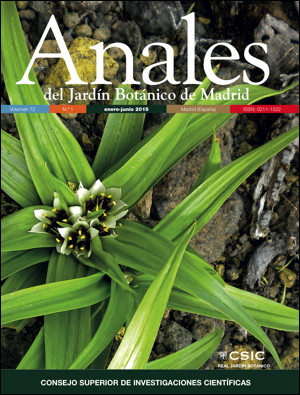Heterostyly in Goniolimon italicum (Plumbaginaceae), endemic to Abruzzo (central Apennines, Italy)
DOI:
https://doi.org/10.3989/ajbm.2365Keywords:
Goniolimon, heterostyly, Apennine, ItalyAbstract
Goniolimon italicum is an endemic species to central Apennines (Italy). Here we provide the first report of heterostyly in this species. Two morphological types were identified: an S-morph with stamen filaments longer than gynoecia, stigmas with a papillate surface and finely reticulated pollen grains with very small spinules (Type B); and an L-morph with stamen filaments shorter than gynoecia, stigmas with a cob pattern and coarsely reticulated pollen grains with small spinules (Type A). Two new locations of G. italicum were found and are here reported.
Downloads
References
Baker, H.G. 1966. The evolution, functioning and breakdown of heteromorphy incompatibility systems. I. The Plumbaginaceae. Evolution 20: 349-368. http://dx.doi.org/10.2307/2406635
Conti, F., Manzi, A. & Pedrotti, F. 1992. Libro rosso delle Piante d'Italia. WWF Italia, Ministero dell'Ambiente, TIPAR, Roma, pp. 637.
Conti, F., Manzi, A. & Pedrotti, F. 1997. Liste rosse regionali delle piante d'Italia. Società Botanica Italiana, Università di Camerino.
Conti, F., Di Santo, D., Giovi, E. & Tinti, D. 2008. Goniolimon italicum Tammaro, Pignatti & Frizzi. Informatore Botanico Italiano 40, suppl. 1: 79-81.
Domina, G. 2011. Plumbaginaceae. – In: Euro+Med Plantbase - the information resource for Euro-Mediterranean plant diversity. Accessed through: Euro+Med PlantBase at http://ww2.bgbm.org/euroPlusMed/ [accessed 02.10.2012].
Dulberger, R. 1992. Floral polymorphisms and their functional significance in the heterostylous syndrome. In: Barrett, S.C.H. (Ed.), Evolution and Function of Heterostyly. Springer-Verlag, Berlin, pp. 41-84. http://dx.doi.org/10.1007/978-3-642-86656-2_3
Ferrero, V., de Vega, C., Stafford, G.I., Van Staden, J., Johnson, S.D. 2009. Heterostyly and pollinators in Plumbago auriculata (Plumbaginaceae). South African Journal of Botany 75: 778-784. http://dx.doi.org/10.1016/j.sajb.2009.06.014
Frattaroli, A.R. 1988. La vegetazione della dolina "Fossa Raganesca" (Appennino centrale- Italia). Documents Phytosociologiques, n.s., 11 (1987): 491-503.
Frizzi, G. 1986. Le piante endemiche dell'Appennino centrale: 1. Goniolimon italicum Tamm., Pign. et Frizzi. (Plumbaginaceae). Micologia e Vegetazione Mediterranea 1: 26-30.
Greuter, W., Burdet, H.M. & Long, G. 1989. Med-Checklist, 4: 320. - Genève.
IUCN. 2001. IUCN Red List Categories and Criteria', version 3.1. IUCN Species Survival Commission. Switzerland and Cambridge, U.K: IUCN, Gland. 30 pp.
Lledó, M.D., Crespo, M.B., Fay. M.F & Chase, M.W. 2005. Molecular Phylogenetics of Limonium and related genera (Plumbaginaceae): biogeographical and systematic implications. American Journal of Botany 92: 1189-1198. http://dx.doi.org/10.3732/ajb.92.7.1189 PMid:21646141
Peruzzi, L., Conti, F. & Bartolucci, F. 2014. An inventory of vascular plants endemic to Italy. Phytotaxa 168: 1-75. http://dx.doi.org/10.11646/phytotaxa.168.1.1
Pirone, G., Corbetta, F., Ciaschetti, G., Frattaroli, A.R. & Burri, E. 2001. Contributo alla conoscenza delle serie di vegetazione nel piano collinare della Valle del Tirino (Abruzzo, Italia Centrale). Fitosociologia 38: 3-23.
Schill, R., Baumm, A. & Wolter, M. 1985. Vergleischende Mikromorphologie der Narbenoberflächen bei den Angiospermen; Zusammenhänge mit Pollenoberflächen bei heterostylen Sippen. Plant Systematics and Evolution 148: 185-214. http://dx.doi.org/10.1007/BF00985924
Tammaro, F., Pignatti, S. & Frizzi, G. 1982. Goniolimon italicum (Plumbaginaceae), una nuova specie rinvenuta nei pressi di L'Aquila (Appennino Centrale). Webbia 36: 34-96. http://dx.doi.org/10.1080/00837792.1982.10670238
Downloads
Published
How to Cite
Issue
Section
License
Copyright (c) 2015 Consejo Superior de Investigaciones Científicas (CSIC)

This work is licensed under a Creative Commons Attribution 4.0 International License.
© CSIC. Manuscripts published in both the print and online versions of this journal are the property of the Consejo Superior de Investigaciones Científicas, and quoting this source is a requirement for any partial or full reproduction.
All contents of this electronic edition, except where otherwise noted, are distributed under a Creative Commons Attribution 4.0 International (CC BY 4.0) licence. You may read the basic information and the legal text of the licence. The indication of the CC BY 4.0 licence must be expressly stated in this way when necessary.
Self-archiving in repositories, personal webpages or similar, of any version other than the final version of the work produced by the publisher, is not allowed.















